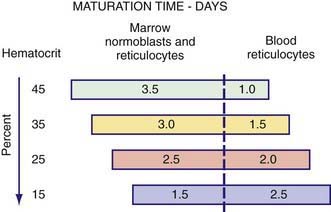Chapter 451 Definitions and Classification of Hemolytic Anemias
Hemolysis is defined as the premature destruction of red blood cells (RBCs). Anemia results when the rate of destruction exceeds the capacity of the marrow to produce RBCs. Normal RBC survival time is 110-120 days (half-life, 55-60 days), and approximately 0.85% of the most senescent RBCs are removed and replaced each day. During hemolysis, RBC survival is shortened, the RBC count falls, erythropoietin is increased, and the stimulation of marrow activity results in heightened RBC production, reflected in an increased percentage of reticulocytes in the blood. Thus, hemolysis should be suspected as a cause of anemia if an elevated reticulocyte count is present. The reticulocyte count also may be elevated as a response to acute blood loss or for a short period after replacement therapy for iron, vitamin B12, or folate deficiency. The marrow can increase its output 2- to 3-fold acutely, with a maximum of 6- to 8-fold in long-standing hemolysis. The reticulocyte percentage can be corrected to measure the magnitude of marrow production in response to hemolysis as follows:
where µ is a maturation factor of 1-3 related to the severity of the anemia (see ![]() Fig. 451-1 on the Nelson Textbook of Pediatrics website at www.expertconsult.com). The normal reticulocyte index is 1.0; therefore, the index measures the fold increase in erythropoiesis (e.g., 2-fold, 3-fold).
Fig. 451-1 on the Nelson Textbook of Pediatrics website at www.expertconsult.com). The normal reticulocyte index is 1.0; therefore, the index measures the fold increase in erythropoiesis (e.g., 2-fold, 3-fold).

Figure 451-1 Number of days for maturation of reticulocytes to mature erythrocytes in the marrow and blood. The duration of maturation as blood reticulocytes is taken as µ, which is used in the correction equation in this chapter.
(Modified from Hillman RS, Finch CA: Red cell manual, Philadelphia, 1983, FA Davis.)
As anemia becomes more severe, the erythropoietin concentration increases and reticulocytes are released from the marrow earlier; they are identifiable as reticulocytes in the blood that last for >1 day. Because the reticulocyte index is essentially a measure of RBC production per day, the maturation factor, µ, provides this correction (see Fig. 451-1
Stay updated, free articles. Join our Telegram channel

Full access? Get Clinical Tree



